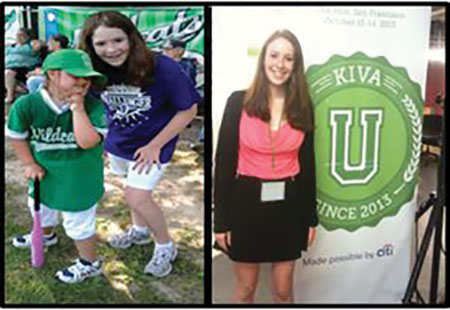Mitzvah project for life?
Published November 13, 2013
For many Jewish pre-teens, the most daunting aspect of their bar/bat mitzvah is the idea of a mitzvah project, or an act of charity that betters the community. After it is successfully completed, numerous experience a sense of fulfillment, and promise to further this charitable activity with their organization of choice. Yet, do they really follow through with this vow? Are the b’nai mitzvahs even in contact with their mitzvah charity?
As one of St. Louis’s largest Jewish organizations, the Harvey Kornblum Jewish Food Pantry seems like an obvious choice of bar/bat mitzvahs to perform their act of charity.
“I would say anywhere from two-three dozen [b’nai mitzvah’s perform their mitzvah project here] a year”, said Cory Eichorn, current manager of the Jewish Food Pantry.
ADVERTISEMENT
While this is a considerable number of volunteers, many of the actual individuals enlisting help change yearly.
“I think that [b’nai mitzvah’s] enjoy their time while they are here, and feel as though it is a worthy cause, but after they have completed their project, we don’t really see them”, said Eichorn.
Although many b’nai mitzvah’s cease contact with the food pantry, members of this organization are aware that their actions make a large impact on the charity, and are greatful for their service.
“The b’nai mitzvah students who choose to do a project here make a meaningful contribution to our mission and success. Some are exposed to their first and only experience of helping out in a food pantry, and others come back after their project is completed with parents or grandparents who volunteer here regularly. Either way, we love hearing from these wonderful young adults about how rewarding their experience was,” said Anna Lehrke, an associate of Eichorn’s and current coordinator of volunteers at the food pantry.
ADVERTISEMENT
Shoshana Williams, a tenth grader at John Burroughs School and a member of CRC wrote her own definition of a mitzvah project. Back in 2010, while preparing for her bat mitzvah, Shoshana participated in “Challenger Baseball”, a program which gives disabled children the opportunity to play baseball with the aid of “buddies”.
“For many of the kids, this was the highlight of their week,” said Shoshana. As a main component of her mitzvah project, she visited school classrooms in order to promote Challenger Baseball, which proved to be a great success.
“Many of the children who I talked to back in 2010 are still involved in this program” she said.
While Shoshana is not still directly working with Challenger Baseball, she described the entire mitzvah project experience as a metaphorical “springboard” to getting involved in other charities and community service opportunities. She feels that this may have even “sprung” her into participating in charities that focus on more significant issues. In fact, after receiving a donation in her honor to KIVA as a bat mitzvah gift, (an organization that gives out micro-loans to people in developing countries for business startup), she decided to get involved. Shoshana is now a leading member in KIVA, and recently attended their national conference in San Francisco. Although quite assured that challenger Baseball is a wonderful organization that makes a tremendous difference in the lives of disabled children, Shoshana stated that KIVA may pack more of a punch as far as dealing with critical issues.
“In Challenger Baseball, a kid got to play baseball once a week,” said Shoshana “but with a loan, someone could create a whole livelihood”.
MICDS students Jack Kanterman and Alex Jasper had similar experiences with their mitzvah project. Alex, a sophomore and member of congregation Shaare Emeth, had his bar mitzvah in the summer of 2010. For his act of charity, Alex donated used shoes to a Nike organization where they were recycled and turned into new sport-courts and playgrounds for children in need.
“I feel like the purpose of a mitzvah project is to help out people that you would not normally help and to also serve the community,” said Alex, who, although not currently in contact with the Nike organization, knows that he has made a difference in the community.
Likewise, freshmen and CRC congregate Jack decided to perform his mitzvah project with a cause that concerned sports as well. In the months leading up to his bar mitzvah, (which took place the summer of 2012), Jack volunteered his time and money to the “Lift for Life” gym in inner-city St. Louis; an organization where under-privileged children get the opportunity to participate in sports and activities they would otherwise not have the convenience to partake in. With the money Jack collected, Lift for Life was able to create several sports teams that still exist today. While he does not volunteer his time for this charity anymore, Jack says that he still sends them money whenever he has the chance.
“[The meaning of mitzvah projects is] volunteering your own time to support an organization or group of people that need your help,” said Jack.
While volunteering at Lift for Life, Jack was exposed to many other community service opportunities.
“I was able to become familiar with food bank, and volunteer there”, he said.
When it comes down to it, the majority of b’nai mitzvah’s do not remain in contact with their mitzvah project organization after their ceremony. What really matters, though, is that they made a lasting impact on the community and found new open doors pertaining to community service.
“If [b’nai mitzvah’s] just want to get service hours, that is fine because we are able to get the job done,” said Cory Eichorn, “What is important to us is that we serve the community well; where, how, and why is not an issue.”















